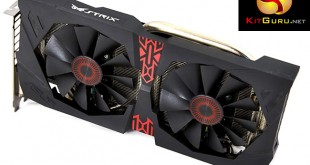
For many gamers the sweet spot for graphics cards is around the £200 mark. Over the years this has been a truly competitive sector with both AMD and NVIDIA vying aggressively for market share. With this specifically in mind AMD have just updated their range, releasing the R9 380X which will hit retail at £199.99 inc vat. So how does it stack up?
In today's market there are surprisingly few current generation GPU options available at the £200 mark. Nvidia have had the GTX970 available for some time, but the prices for these cards are firmly in the £250 sector (HERE). Their less powerful GTX 960 is £100 less, available around £150 (HERE). AMD released their R9 380 earlier this year, and prices are competitive against the GTX960 (HERE). The R9 390 is AMD's solution directly priced to compete against the GTX970 (HERE).
Based on this information we can see that the AMD R9 380X is occupying a lone spot at £199.99 inc vat right now. Well – that is until Nvidia bring a new card out to specifically target this price point.
| GPU | R9 390X | R9 290X | R9 390 | R9 290 | R9 380X | R9 380 | R9 285 | Fury X | Fury |
| Launch | June 2015 | Oct 2013 | June 2015 | Nov 2013 | Nov 2015 | June 2015 | Sep 2014 | June 2015 | June 2015 |
| DX Support | 12 | 12 | 12 | 12 | 12 | 12 | 12 | 12 | 12 |
| Process (nm) | 28 | 28 | 28 | 28 | 28 | 28 | 28 | 28 | 28 |
| Processors | 2816 | 2816 | 2560 | 2560 | 2048 | 1792 | 1792 | 4096 | 3584 |
| Texture Units | 176 | 176 | 160 | 160 | 128 | 112 | 112 | 256 | 224 |
| ROP’s | 64 | 64 | 64 | 64 | 32 | 32 | 32 | 64 | 64 |
| Boost CPU Clock | 1050 | 1000 | 1000 | 947 | 970 | 970 | 918 | 1050 | 1000 |
| Memory Clock | 6000 | 5000 | 6000 | 5000 | 5700 | 5700 | 5500 | 500 | 500 |
| Memory Bus (bits) | 512 | 512 | 512 | 512 | 256 | 256 | 256 | 4096 | 4096 |
| Max Bandwidth (GB/s) | 384 | 320 | 384 | 320 | 182.4 | 182.4 | 176 | 512 | 512 |
| Memory Size (MB) | 8192 | 4096 | 8192 | 4096 | 4096 | 4096 | 2048 | 4096 | 4096 |
| Transistors (mn) | 6200 | 6200 | 6200 | 6200 | 5000 | 5000 | 5000 | 8900 | 8900 |
| TDP (watts) | 275 | 290 | 275 | 275 | 190 | 190 | 190 | 275 | 275 |
The R9 380X is quite similar in specification with the R9 380 – incorporating 32 ROPs, a 256 bit memory interface with core clocks and memory clocks both set to reference speeds of 970 mhz and 1425 mhz (5.7Gbps effective) respectively. There are however 128 texture units on the R9 380X, compared with the R9 380's 112. The Stream Processor count has also been increased from 1792 to 2048.
The ASUS Strix R9 380X DirectCU II OC has enhanced clock speeds, and we will look at this in more detail on the next page of the review.
For the last couple of weeks we have been testing many graphics cards with the latest AMD and Nvidia drivers and we made the switch to the 64 bit version of Windows 10 as well.
 KitGuru KitGuru.net – Tech News | Hardware News | Hardware Reviews | IOS | Mobile | Gaming | Graphics Cards
KitGuru KitGuru.net – Tech News | Hardware News | Hardware Reviews | IOS | Mobile | Gaming | Graphics Cards




Would you agree that at this point is maybe pointless to upgrade GPU. I wanted to buy this card and although performance is there i think that would very much regret the purchase. I’m reffering to upcoming GPUs next year.
I would not agree, honestly. I am of the opinion that one should use what they have until they are unhappy with the experience they’re getting with what they have, and then upgrade with what’s out now.
Unless there’s an I-have-to-have-the-newest-thing going on – which is perfectly okay, too, and which I’m occasionally guilty of – there’s no real need to upgrade anything if you’re happy with what you’ve got.
And personally, I think the “wait to see what the next new thing looks like before making a decision” is a neverending game to play, especially with graphics cards. With the 380x, AMD’s new(ish) lineup is pretty much complete (except for the presumed dual-Fiji card), but Nvidia’s Pascal is, metaphorically speaking, right around the corner. But when Pascal comes out, AMD’s Arctic Islands will be right around the corner. And when Arctic Islands comes out, Nvidia’s Volta will be right around the corner. Ad nauseam.
IMHO, if you want to wait for Pascal or Arctic Islands, and will enjoy your current gaming experience while you wait, then do it. I don’t blame you. But make up your mind to purchase *something* after it comes out. If it’s revolutionary, and at a cost you can afford, you’ll be darned glad you waited. If it doesn’t live up to the hype, and 980s are dropping in price and would be – and this is the important part – more than enough for what you’re playing and plan to play, then you’ve saved some money and your gaming experience will be much improved.
(And, if you’re looking at dropping 200 on THIS card today, but decide to wait until Pascal, you can stash the 200 you have into the GPU fund, and keep adding to it for the next 6 months – you’ll end up with a lot more money for a lot higher-end card than this one.) (edited because I was thinking in dollars and not pounds. Sorry. lol)
But if you’re interested in buying now, or your gaming is suffering and you *need* something soon, the present generation of cards will still be as powerful as your wallet will allow you. (The setup I’m on is no 16-core 3-GPU powerhouse or anything, but it’s running Fallout 4 maxed out like an absolute champ, so I’m probably not looking at new GPU or CPU or RAM until Arctic Islands or Volta.)
You have valid point. Also, thank you for a nice, big, explanation. I was asking specifically because i’m not that kind of gamer that needs to have the all latest that comes to market… I always keep my hardware atleast 2 years, 3 maybe and that is way i’m somewhat concerned… But your explanation gives me one hell of headache, because i know that i can sell my card to someone. 😀